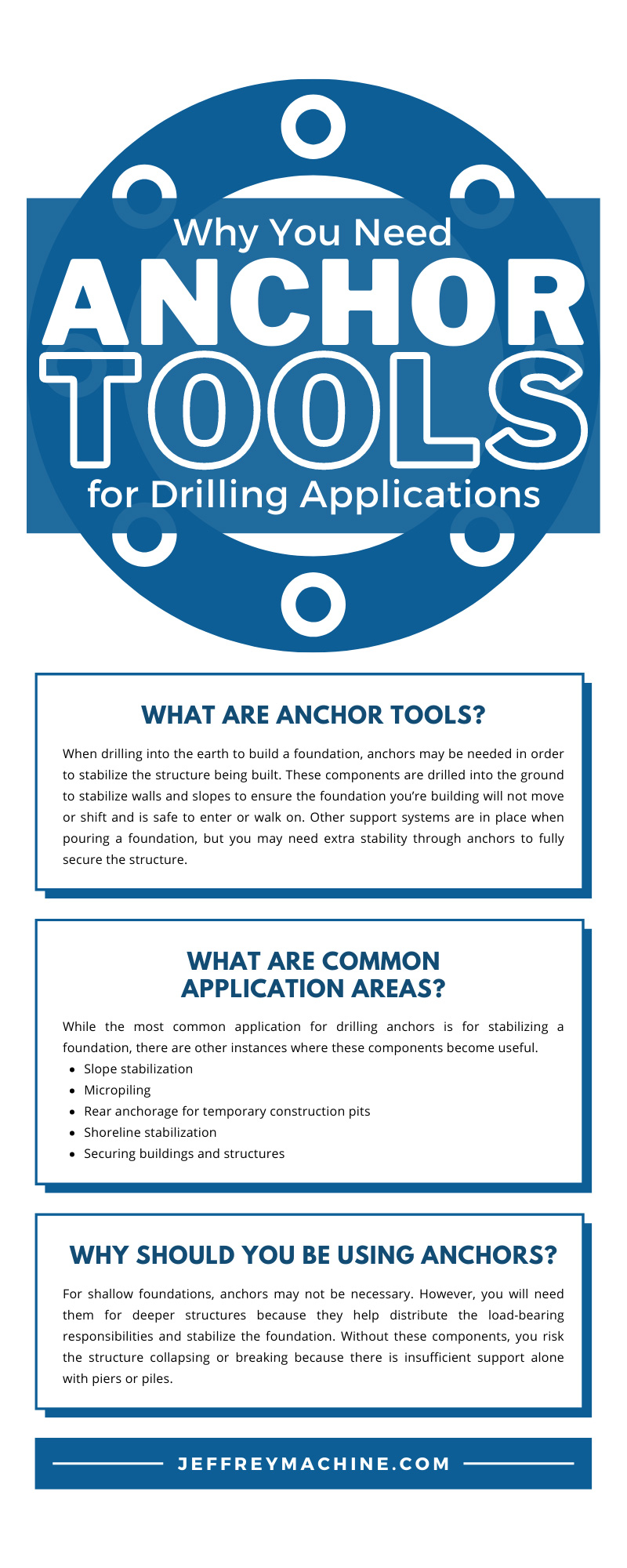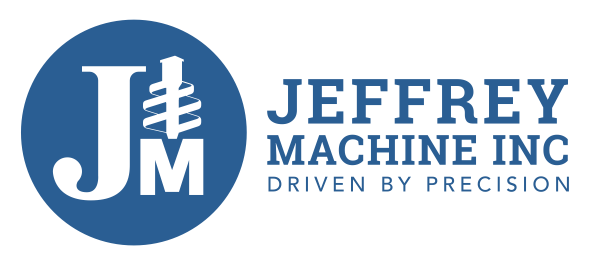Why You Need Anchor Tools for Drilling Applications

When performing drilling applications for building foundations or bridges, anchor tools are needed to support and stabilize a structure. Without these components, the building could eventually collapse or become dangerous throughout construction because the weight of the foundation is not evenly distributed. Extra support may be needed to support unstable soils or slopes, making anchoring tools necessary.
Learn what these anchor tools are, what applications you could use them in, Jeffrey Machine’s specific components for sale, and why you must use them throughout the work on a construction site.
What Are Anchor Tools?
When drilling into the earth to build a foundation, anchors may be needed in order to stabilize the structure being built. These components are drilled into the ground to stabilize walls and slopes to ensure the foundation you’re building will not move or shift and is safe to enter or walk on. Other support systems are in place when pouring a foundation, but you may need extra stability through anchors to fully secure the structure.
This may not be necessary for smaller structures because the foundation is much shallower and closer to the ground. Larger structures, like tall offices or bridges on highways, need a deeper foundation to ensure there is no movement as it settles. Anchors in these applications are drilled deep into the ground—far enough to reach bedrock—to help transfer some of the load-bearing responsibilities from your piles or piers to the anchors. The column on the anchors is then attached to the structure to stabilize the base fully.
What Are Common Application Areas?
While the most common application for drilling anchors is for stabilizing a foundation, there are other instances where these components become useful.
- Slope stabilization
- Micropiling
- Rear anchorage for temporary construction pits
- Shoreline stabilization
- Securing buildings and structures
Each application is different, therefore requiring other techniques for placing the anchors. Furthermore, the type of soil you’re working with could also determine how you deploy the anchor into the ground. In some cases, these components could be permanent supports or temporary anchors as the construction team work on projects.
Specific Examples of Anchoring
Now that you understand some of the more common application areas, here are a few more specific examples so you can get a better idea of how and why you need anchor tools for drilling applications so that you and other workers remain safe on the job site.
Utility Anchoring
For utility employees to work more safely and efficiently, using an auger with anchor attachments allows the worker to use less manpower to stabilize slopes, walls, and other objects. This machine can quickly penetrate through the soil for permanent anchoring. Installing an anchor by hand could take much longer than it would if you used a digger. Drilling anchors could allow workers to get through more tasks because it’s less time-consuming with an auger.
Jeffrey Machine Anchors & Components
At Jeffrey Machine, we provide our customers with various types of anchors for applications. Our adapters can be temporary or permanent, and we offer single and multi-strand components for more support. Below you can find a brief description of our anchors. If you have any questions, do not hesitate to contact our professionals for advice and help.
Locking Dog Assembly
A locking dog assembly will attach to the adapter and make installing the anchor rod effortless. The rings on this component grip the drive wrench and anchor rod while holding them secure under torque. Once the components are in place, this adapter will release them to support a structure.
To ensure you’re choosing the right locking dog assembly, take a look at our specifications. Otherwise, you might accidentally select the wrong size Kelly bar or drive wrench for the application, which could not fit properly into the assembly.
Helical Pier Anchors
Helical pier anchors work great for deeper foundation applications where the soil is expansive or unstable and there are high water tables. This is mostly for jobs in which tension or compression is needed to hold a structure. This system uses helical bearing plates welded to a steel shaft; the load is then transferred from this shaft to the soil through bearing plates to help support the weight of the foundation.
Bolt Circle Kelly Bar Adapters
Jeffrey Machine’s bolt circle Kelly bar adapters utilize various other anchor tools in conjunction with this one to create a complete system for foundation support. The locking dog assembly, for example, can attach the Kelly bar adapter through the bolt circle. This system consists of the Kelly bar adapter, a torque indicator, a lock dog assembly, and a drive-end wrench.
However, you must choose an adapter with the correct size and torque rating, or you could damage the auger motor. Measure your Kelly bar across the flats beforehand to determine the adapter size. Find the maximum torque output on the equipment and choose a Kelly bar equal to or greater than the torque.
Why Should You Be Using Anchors?
For shallow foundations, anchors may not be necessary. However, you will need them for deeper structures because they help distribute the load-bearing responsibilities and stabilize the foundation. Without these components, you risk the structure collapsing or breaking because there is insufficient support alone with piers or piles.
It is always best practice to use these anchors, even if you might not need them the entire time. Temporary components will help stabilize the construction site as the crew works through building the foundation. Jeffrey Machine offers high-quality anchor tooling and adapters that are excellent for these applications. Contact us today or browse through our selections.

